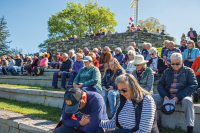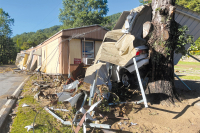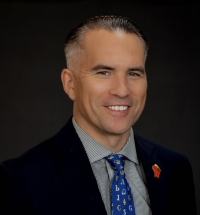1882 Cowee Tunnel disaster comes into 21st century spotlight
 Charged with stealing, 15-year-old Charles Eason was sentenced to work on a prison chain gang.
Charged with stealing, 15-year-old Charles Eason was sentenced to work on a prison chain gang.
It was 1882, and the teenager from Martin County soon found himself side-by-side with other convicts, many two and three times his age. Mostly from the eastern part of the state, the gang was sent to construct the railroad lines in Western North Carolina.
Their hard, arduous labor — and that of other chain gains like them — shaped the development of Southern Appalachia into a bountiful economy based on lumber and minerals, now easily transported by rail out of the mountainous landscape and into the world of commerce.
But Mason wouldn’t ever get to the see fruits of his hard work. After months of forced labor, he and 18 other African-American inmates drowned while crossing the Tuckasegee River in their workboat to do work on the Cowee Railroad Tunnel. Their shackles pulled them to their death at the bottom of a frigid river. All 19 bodies were carelessly dumped into a mass grave in Dillsboro, left behind and forgotten for the next 130 years.
“It depresses me terribly that this much time has gone by and nobody cared,” said Gary Carden, a well-known Western North Carolina writer and artistic director of The Liar’s Bench. “The world can be rotten at the heart.”
Related Items
Forgotten, that is, until a group of Jackson County residents took matters into their own hands. Spearheaded by Carden and others involved in The Liar’s Bench — a Southern Appalachian cultural variety show featuring regionally prominent musicians and folklorists — the latest interest in the disaster has revealed new details, as well as opened a can of worms about a dark era in American history.
“The world is full of stories where a town has to redeem itself, and I don’t think Jackson County knows it has to redeem itself,” Carden said. “This is a dangerous world, and this disaster validates the kind of a world we live in where you can leave home and never come back.”
Shipped up the river
Though slavery was abolished following the Civil War and the passage of the 13th Amendment, African-Americans were still treated as second-class citizens, especially in the South. Criminalizing legal activities by African-Americans, the “Black Codes” were a harsh list of laws created to wrangle and imprison blacks. These laws put African-Americans behind bars for simply walking down the street after dusk or traveling through an area without a permanent place of residence.
With staggering numbers of new black prisoners filling the jail system, state governments eventually constructed a system of taking them out of their cells and putting them to work, mainly doing hard labor for various job sites around the South. The prison system made enormous sums of money off the cheap labor, while businesses were able to complete seemingly impossible projects with minimal cost and a never-ending flow of dispensable workers.
With this new resource of workers, plantation owners were also legally allowed to purchase the services of the prisoners, which were almost always African-Americans.
“You’ve got to keep in mind this is in the years following the Civil War. It was the end of slavery, but this part of the country was still used to the idea of utilizing people for labor without any real compensation,” said George Frizzell, head of special collections at Hunter Library at Western Carolina University. “Exploitable labor was still part of the mindset, and some people didn’t see this as a big concern that the state was leasing these prisoners in this way.”
Once purchased, these businesses could lease the men from the state for upwards of a year. Along with the leased ownership came the harsh reality of horrid working conditions, brutal beatings and the occasional killing of a prisoner at the hands of the businesses. The accountability was nil as the steady stream of workers continued to flow in.
“These weren’t just a casual everyday type of labor. We’re talking hard, hard physical labor under extreme conditions, led by people that didn’t mind using convict labor,” Frizzell said.
The building of railroads became one of the largest projects taken on by the prison chain gangs. During the post-Civil War years, the United States continued to push westward, as well as expand the connectivity of the already populated East Coast. The frenzied need for exploration and cultivating of natural resources like lumber and minerals only increased the need for speedy construction or rail lines through the country.
“The creation of the railroad really joined together the United States,” Frizzell said. “It linked the East and West coasts, and lingering in the background through this fascination with the railroad was the realization that so many people were sacrificed in doing so.”
On a typical day, the prisoners were shackled together, the chains attached around their ankles and linked up to the next convict and so on. They cleared forests, removed rock, dug tunnels and laid heavy steel rail lines for hundreds of miles. If they slowed down, they were beaten. If they tried to run away, they were shot. No questions asked, no compassion given.
And amid this massive railroad bonanza came the development of the densely forested and rugged landscape of Western North Carolina. Filled with enormous untouched lumber and rich mineral beds, the region had businesses licking their lips for decades. The problem was how to get the resources out of ground and to markets. The solution came from the emerging railroad and cheap prison labor.
“The railroad had such a vital impact on the economical development of this area,” Frizzell said. “With the timber and mining now available, the railroad reshaped everything here, and a lot of people don’t realize it was built with convict labor.”
A frigid, deathly day
The Western North Carolina Railroad had assembled a workforce of hundreds of convicts from a prison in Raleigh. Rail lines were quickly moving across the state, with the 700-foot long Cowee Tunnel outside of Dillsboro being built ahead of the line to keep up with the pace of construction.
It was cold in Dillsboro on the morning of Dec. 30, 1882. Snow and ice covered the ground, and the frigid Tuckasegee River flowed through the small community.
A group of 30 convicts entered a boat on the eastern bank of the river, readying themselves to head across the water to their jobsite at the Cowee Tunnel (1.3 miles west of Dillsboro) on the other side.
“You’ve got to remember the physical surroundings in Western North Carolina hardly resembles what they were in 1882,” said Dave Waldrop, assistant to the artistic director at The Liar’s Bench. “There were trees with trunks 12 to 14 feet in diameter. These convicts had never been in such a wild and intimidating wilderness like this, and it probably frightened them not knowing what was going to happen while working out there.”
As the boat was pulled across the river by a cable line, puddles of water from a rainstorm the previous night were swishing back and forth on the wooden floor. The sight and sound of the water began to scare the prisoners, with many thinking the boat was sinking. Panicking, the convicts began to push towards the front of the boat. Prison guards ordered the men to stop moving around in the boat, but it was to no avail. With the commotion and constant back and forth movement of the craft, the boat capsized, sending everyone onboard into the frozen river.
Struggling to get to shore, the men, shackled together, tried desperately to keep their heads above water. One by one, the entangled mass of convicts slipped to the bottom of the river, ultimately to their demise. First hand accounts told of eyewitnesses on the riverbanks watching helplessly as the men cried for help and eventually drowned. The other 11 convicts and guards on the boat were swept down the river.
In a February 1963 article by the Asheville Citizen-Times, well-known Sylva writer John Parris spoke of the legendary heroics of convict Anderson Drake, who climbed out of the river only to dive back in and rescue prison guard Fleet Foster.
“Drake helped Foster up the steep bank, knelt a moment by the gasping guard, then stood up and turned to look back at the foaming river. There was no sign of the other 19 convicts,” Parris wrote. “They called Drake a hero. They said he would surely go free.”
But Drake didn’t go free. Back in his quarters, following the incident, Foster found his wallet and pistol missing. Upon ordering a search of the prison camp, the wallet, containing $30, was found in Drake’s belonging.
“That night, instead of thanking Drake and giving him a feast, the camp foreman ordered him into the yard, bared his back, and gave a dose of cat-o’-nine-tails (multi-tailed whip),” Parris wrote.
After the lashings, Parris reported Drake was sentenced to 30 years hard labor and immediately put back to work on the Cowee Tunnel.
On New Year’s Day 1883, the 19 bodies of the convicts were finally pulled from the river. An investigation ruled the deaths accidental, with a guard’s statement concluding the incident was of no fault to anyone. Reports and local legend had said the prisoners were buried on the hill atop the tunnel, while replacement workers came in and the railroad construction continued to move on down the line. The names of the deceased were filed away, eventually covered up and forgotten by the sands of time.
“Days later, the 19 bodies were recovered and buried in unmarked graves on the hillside above the river and in plain view of the mouth of the tunnel,” Parris wrote.
Though railroad chain gang worker deaths were commonplace at the time, with Chinese immigrants on the West Coast and African-Americans on the East Coast, the sheer number of fatalities in this tragedy made national headlines.
The Dillsboro accident was described as “… the most awful that has happened in any of the public works of this state,” reported the Raleigh Observer.
The tragedy was a particularly embarrassing blow for then-Gov. Thomas Jordan Jarvis, who had recently visited the rail lines in an effort to show solidarity with the railroad companies that worker conditions and line progress were going smoothly.
“There were a lot of people traumatized by the high number of fatalities,” Waldrop said. “The governor was just saying how well everything was going, how well the convicts were being treated, and then this happens.”
And the infamous story, for the most part, was simply left at that.
Once the tunnel was completed, WNC was open for business. But as the years ticked away, the Cowee Tunnel still remained a spot for disaster. Between cave-ins and train derailments on the pitch-black blind curve in the middle of the tunnel, local folklore attributed the incidents to a curse Drake may have placed on the site. Inside the dark and cavernous tunnel, streams of moisture fell from the ceiling and down the walls – tears from the 19 deceased convicts perhaps, many felt.
The injustices towards African-Americans and harsh conditions of chain gangs continued well into the 20th century. It wouldn’t be until the 1950s when state-provided prison labor would be eliminated around the country. The chain gangs were no more, but the deep and disturbing memories and stories remained.
Discovering the past
As a child, Carden was well aware of the legend of the Cowee Tunnel tragedy.
“I had heard about when I was a kid and was always curious about it,” he said. “Who were they? Where are they? Where are the bodies? We still didn’t know everything though about where all these bodies could be.”
Carden kept the tunnel story in the back of his head for years. It wasn’t until this past winter when his curiosity was finally sparked to do something on the issue. He researched numerous documents and newspaper archives, eventually tracking down articles on the tragedy and a complete list of those 19 forgotten prisoners who perished in the river.
“Finding their names really affected me. They had been nameless, they didn’t exist, and suddenly there’s a name and an age,” he said. “And you wonder if they were fat or thin, if they were married or had children.”
Carden soon came across The Road, a 1967 historical fiction novel by John Ehle about the brutal construction of the Swannanoa Tunnel, which was by the same chain gang involved in the Cowee Tunnel. The book follows its protagonist, Weatherby Wright, and his mission to build a railroad in an impossible landscape of thick rock and deep forest. The work brings to life the rigorous 12-hour shifts of manual labor, or working 24 hours a day with minimal food, housing and amenities. Reading it fueled Carden’s fire to bring closure to the 1882 tragedy.
“Families all over North Carolina have that empty place on their family tree where they wonder what happened to their family member that left town and never came back,” Carden said.
Throughout this spring, Carden and Waldrop began interviewing elderly residents around Jackson County. They started pinpointing where the graves might be.
They finally tracked down longtime resident Ellen Sutton, whose property overlooks the tunnel. She told them that the bodies weren’t buried above the tunnel. Rather, the 19 convicts were placed in mass graves on a ridge behind what is now the Jackson County Green Energy Park. It was a statement backed up by Dennis Wilkey, whose property butts against the ridge.
“Dennis knew where the graves were, but he wasn’t too hot on locating them for us,” Carden said. “He finally called one day and said ‘OK, let’s go.’”
Carden and Waldrop headed up the ridge with Wilkey. In 1882, the property was pasture. Now, however, it is overgrown with hard-to-navigate brush.
“There was nothing pastoral about it, just pine needles and thickets,” Carden said.
Though Wilkey knew where the graves were, no one could seem to figure out who currently owns the land they reside on. It had been so long since anybody had taken any interest in it, it seemed many forgot who it actually belonged to.
“Dennis cut us a path and finally showed us the spot where they were buried,” Carden said. “He said that’s where his daddy had showed him they were, which was some 60 years ago.”
During their second visit to the supposed gravesite on April 26, Carden brought along dowser Tom Stewart, whose specialty is locating unmarked human graves with his dowsing rods. Carden had previously used Stewarts talents six years ago in locating dozens of unmarked graves behind an old folks home in Webster.
Stewart strode across the ground. Certain spots were soft when he walked over them and the rods immediately crossed, indicating a gravesite. When he stepped off the spots, the rods uncrossed. They had detected three large graves, which led the group to estimate each holds several bodies.
Going Home Project
At a meeting of the Jackson County Genealogical Society on June 13 in Sylva, Carden and his team presented their findings and showed clips from their interviews with Sutton and Stewart. The clips will be part of an upcoming documentary being made about the tragedy, which will be called “The Going Home Project” – a title signaling the next, and hopefully final, chapter of this 130-year-old story.
“What’s becoming rapidly apparent is that there’s a story here, a significant story,” Carden told the audience. “This is a continuing story, and it’s going to go on for a long time.”
Carden pointed out that there is interest from the forensic department at WCU in digging up and identifying the bodies of the 19 convicts. From that point their immediate families could be located and notified that their ancestors have been found.
“Some people say stuff like this needs to be left alone, but if these people were my family, I would be wondering where they are,” Waldrop said. “We are all seeking our roots, and these workers are part of somebody’s roots.”
“I have mixed feelings about the graves, but right now I want them out of there,” Carden added. “I would like a monument in downtown Dillsboro with the names of those guys on it.”
Sitting in the back of the crowd at the meeting was Victoria McDonald, a Jackson County native, historical author and African-American. Carden interviewed her for the documentary and asked her to come down to the floor and say a few words.
“It hurts my heart to think if someone buried me and didn’t tell my mother where I was,” she said. “These guys are in my heart, they really are. There was no prayer and no blessing when they were thrown in those graves. They were free men, but they weren’t free.”
McDonald said the worst part of the entire tragedy was the lack of closure for the families involved, how these men became anonymous and that nobody seemed to care enough to do the right thing.
“Their folks didn’t know where they were, and the people that took them didn’t know who they were, and they didn’t bother to take them back to their home county,” she said. “That’s what bothers me, too, is that we in this country can’t get over that era, and we have an opportunity to get over something that ruined a lot of lives and a lot of families.”
Carden is currently writing a play about the tragedy. Titled “Tears in the Rain,” he performed a few pages of the script during the presentation, with McDonald singing the traditional slave song “Jordan River” in the background.
“The prisons of the South had formed an unholy alliance,” Carden read. “They were renting chain gang prisoners to some of the old plantations where hundreds of African-Americans found themselves back in the fields like their ancestors of the previous generation.”
Fundraising efforts, suggestions and more research on the exact gravesite is underway. Though the fine details of the tragedy are slowly being pieced together like one giant puzzle, they are becoming clearer and clearer each day. The group is planning to continue the mission to find the relatives of the deceased. For them, in a perfect world, every family would be located and every body shipped home for a proper burial, some 130 years in waiting.
“You get very few chances in life to make a wrong right again, and this is one of those chances,” Waldrop said.
Want to go?
The Liar’s Bench will do a special presentation about the Cowee Tunnel tragedy from 7 to 9 p.m. Thursday, June 20, in the Mountain Heritage Center at Western Carolina University. The group promotes southern Appalachian storytelling, music, poetry, drama, and folk arts. The presentation is free and open to the public. 828.227.7129 or theliarsbenchgazette.blogspot.com.
The Cowee Tunnel 19
Moses Brown, 25 • Warren Co., N.C.
Oren Brooks, 22 • Orange Co., N.C.
Charles Eason,15 • Martin Co., N.C.
Sampson Ward, 55 • Onslow Co., N.C.
Allen Tillman, 18 • Anson Co., N.C.
Robert Robinson, 27 • New Hanover Co., N.C.
Thomas Miller, 30 • Chesterfield, S. C.
James Fisher, 18 • Polk Co., N.C.
Nelson Bowser, 30 • Hertford Co., N.C.
John Newsom, 20 • Hertford Co., N.C.
George Tice, 21 • Iredell Co., N.C.
Jerry Smith, 33 • Wilson Co., N.C.
George Rush, 44 • Richmond Co., N.C.
David Dozier, 52 • Edgecomb Co., N.C.
Jim McCallum, 18 • Gaston Co., N.C.
Albert Cowan, 22 • Rowan Co., N.C.
Louis Davis, 29 • Vance Co., N.C.
Alex Adams, 25 • Washington Co., N.C.
John Whitfield, 20 • Wayne Co., N.C.









